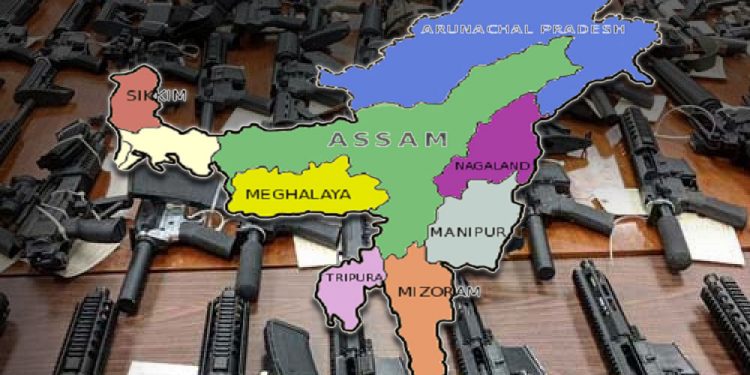
SOURCE: NENOW
Increasing seizures of Chinese weapons in Northeast India points to a greater flow of illegal arms impacting adversely on regional stability, says a Home Ministry report . That such weapons are also being pushed — even assembled into Myanmar — is an additional cause for worry because many troubled areas of the neighbouring country border on Northeast, it adds.
As many as 423 illegal weapons, including AK-47s, M-16s, Chinese pistols and Lathodes, have been recovered so far this year in various states of Northeast.
“Prominent insurgent groups, especially those from Assam, Manipur, Nagaland and Mizoram, maintain regular contact with Chinese intelligence agencies and have benefited from Chinese largesse and weapons,” says the report compiled by the Intelligence Bureau.
The agency report says training of insurgent groups in the northeast, provisioning of arms and ammunition and harbouring exiled militants and leaders have been recurrent facets of China’s ‘diplo-terrorism’ against India since the 1960s.
It says the trend is now growing.
A large consignment of Chinese made weapons comprising AK 47 assault rifles, machine guns, anti-tank mines, grenades and ammunition of a total value of approximately $1 million was seized in Mae Sot district on the Thai side of the Myanmar-Thailand border.
This was meant for Myanmar and possibly Northeast India.
These seized consignments are not the only consignment of Chinese weapons that was heading for the region.
Earlier this year, a large cache of 500 assault rifles, 30 Universal Machine Guns, 70,000 ammunition rounds, a huge stock of grenades and significantly, a few F-6 Chinese Manpads, were offloaded at Monakhali beach near the coastal junction of Myanmar and Bangladesh.
From there, the consignment reached the Arakan Army Camp near Thanchi in Chittagong Hill Tracts (CHT) on way to Rakhine through jungles below the Parva corridor in South Mizoram.
The seized weapons were original Chinese hardware and were meant for the Arakan Army that is fighting against Myanmar government and disrupting India’s Kaladan Multimodal Transport Transit project in Rakhine-Chin region.
The Arakan Army was raised in 2009, under the Kachin Independence Organisation along the China border – the same year the Kaladan project was declared by India.
In 2019, when a phase of the Kaladan project was nearing its completion, the Arakan Army shifted its area of operation to Rakhine and Southern Chin.
More than 593 instances of clashes between the Arakan Army and Myanmar were reported in 2019, majority of which were in close proximity to the Kaladan Project.
The Arakan Army, however, has always kept its anti-Kaladan activities below a certain threshold to avoid raising the threshold of Indian patience.
Nevertheless, there have been more than four instances of targeting of shipments/attacks on Myanmar Army providing security and abductions (claimed to be mistaken identity) which overall has severely impeded the execution of the project.
Interestingly, the Arakan Army has also declared its decision to levy taxes on the Indian project, while in the same breath it has exempted all ongoing Chinese projects in the region like the Kyaukphyu Port and SEZ .
The Myanmar government reduced the Chinese funded project by half fearing a Sri Lanka type debt trap.
Western intelligence agencies say China provides up to 95 per cent of Arakan Army’s funding.
The source also stated that the Myanmar Army has acknowledged the ‘Hunting with the hounds and running with the foxes’ strategy of China, with Army chief Senior General Min Aung Hlaing bringing up the issue with visiting Chinese President Xi Jinping in January 2020.
China had then categorically denied it.
What worries India are large recent seizures of Chinese weapons in a peaceful state like Mizoram which intelligence agencies think has emerged on one of the key routes of weapons peddling — Monakhali coast-Thanchi- Parva-Chin/ Rakhine.
Not merely the Arakan Army or ARSA’s Rohingya militants, but also groups like NSCN(I-M) are able to source this routes for amassing weapons.
That, says intelligence officials, have helped these factions increase their armories. Some of these consignments also reach the Maoist underground in eastern and central India.






